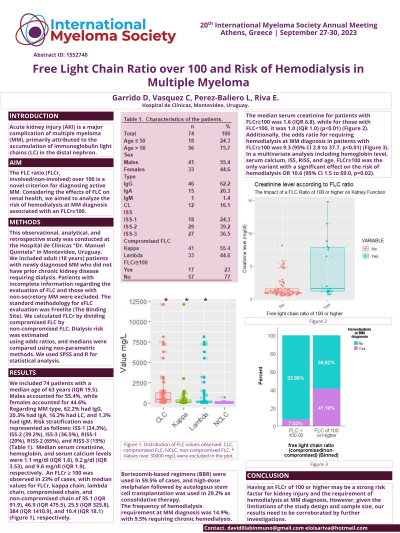QoL and Patient-Reported Outcome and Supportive Care
Poster Session 3
P-462: Free Light Chain Ratio over 100 and Risk of Hemodialysis in Multiple Myeloma
Friday, September 29, 2023
1:15 PM - 2:15 PM EEST


Eloísa Riva, MD (she/her/hers)
Associate Professor of Hematology G4
Hospital de Clinicas, Montevideo, Uruguay
Montevideo, Montevideo, Uruguay
Introduction: Acute kidney injury (AKI) is a major complication of multiple myeloma (MM), primarily attributed to the accumulation of immunoglobulin light chains (LC) in the distal nephron.
Objective. The FLC ratio (FLCr, involved/non-involved) over 100 is a novel criterion for diagnosing active MM. Considering the effects of FLC on renal health, we aimed to analyze the risk of hemodialysis at MM diagnosis associated with an FLCr≥100.
Methods: This observational, analytical, and retrospective study was conducted at the Hospital de Clínicas "Dr. Manuel Quintela" in Montevideo, Uruguay. We included adult (18 years) patients with newly diagnosed MM who did not have prior chronic kidney disease requiring dialysis. Patients with incomplete information regarding the evaluation of FLC and those with non-secretory MM were excluded. The standard methodology for sFLC evaluation was Freelite (The Binding Site). We calculated FLCr by dividing compromised FLC by non-compromised FLC. Dialysis risk was estimated using odds ratios, and medians were compared using non-parametric methods. We used SPSS and R for statistical analysis.
Results: We included 74 patients, median age was 63 years (IQR 19.5), 55.4% were male. Regarding MM subtype, 62.2% had IgG, 20.3% had IgA, 16.2% had LC, and 1.3% had IgM. Risk stratification was represented as follows: ISS-1 (24.3%), ISS-2 (39.2%), ISS-3 (36.5%); RISS-1 (20%), RISS-2 (65%), and RISS-3 (15%). Median serum creatinine, hemoglobin, and serum calcium levels were 1.1 mg/dl (IQR 1.6), 9.2 g/dl (IQR 3.53), and 9.6 mg/dl (IQR 1.9), respectively. An FLCr ≥ 100 was observed in 23% of cases, with median values for FLCr, kappa chain, lambda chain, involved chain, and non-involved chain of 35.1 (IQR 91.9), 46.9 (IQR 475.5), 25.5 (IQR 325.8), 384 (IQR 1410.9), and 10.4 (IQR 18.1), respectively. Bortezomib-based regimens (BBR) were used in 59.5% of cases, and high-dose melphalan followed by autologous stem cell transplantation was used in 29.2% as consolidative therapy.
The frequency of hemodialysis requirement at MM diagnosis was 14.9%, with 9.5% requiring chronic hemodialysis. The median serum creatinine for patients with FLCr≥100 was 1.6 (IQR 6.8), while for those with FLCr < 100 it was 1.0 (IQR 1.0) (p < 0.01). Additionally, the odds ratio for requiring hemodialysis at MM diagnosis in patients with FLCr≥100 was 9.3 (95% CI 2.8 to 37.7, p< 0.01). In a multivariate analysis including hemoglobin level, serum calcium, ISS, RISS, and age, FLCr≥100 was the only variable with a significant effect on the risk of hemodialysis OR 10.6 (95% CI 1.5 to 69.0, p=0.02).
Conclusions: An FLCr≥100 is a strong risk factor for kidney injury and renal replacement requirement. However, given the limitations of the study design and sample size, our results need to be corroborated by further investigations.
Objective. The FLC ratio (FLCr, involved/non-involved) over 100 is a novel criterion for diagnosing active MM. Considering the effects of FLC on renal health, we aimed to analyze the risk of hemodialysis at MM diagnosis associated with an FLCr≥100.
Methods: This observational, analytical, and retrospective study was conducted at the Hospital de Clínicas "Dr. Manuel Quintela" in Montevideo, Uruguay. We included adult (18 years) patients with newly diagnosed MM who did not have prior chronic kidney disease requiring dialysis. Patients with incomplete information regarding the evaluation of FLC and those with non-secretory MM were excluded. The standard methodology for sFLC evaluation was Freelite (The Binding Site). We calculated FLCr by dividing compromised FLC by non-compromised FLC. Dialysis risk was estimated using odds ratios, and medians were compared using non-parametric methods. We used SPSS and R for statistical analysis.
Results: We included 74 patients, median age was 63 years (IQR 19.5), 55.4% were male. Regarding MM subtype, 62.2% had IgG, 20.3% had IgA, 16.2% had LC, and 1.3% had IgM. Risk stratification was represented as follows: ISS-1 (24.3%), ISS-2 (39.2%), ISS-3 (36.5%); RISS-1 (20%), RISS-2 (65%), and RISS-3 (15%). Median serum creatinine, hemoglobin, and serum calcium levels were 1.1 mg/dl (IQR 1.6), 9.2 g/dl (IQR 3.53), and 9.6 mg/dl (IQR 1.9), respectively. An FLCr ≥ 100 was observed in 23% of cases, with median values for FLCr, kappa chain, lambda chain, involved chain, and non-involved chain of 35.1 (IQR 91.9), 46.9 (IQR 475.5), 25.5 (IQR 325.8), 384 (IQR 1410.9), and 10.4 (IQR 18.1), respectively. Bortezomib-based regimens (BBR) were used in 59.5% of cases, and high-dose melphalan followed by autologous stem cell transplantation was used in 29.2% as consolidative therapy.
The frequency of hemodialysis requirement at MM diagnosis was 14.9%, with 9.5% requiring chronic hemodialysis. The median serum creatinine for patients with FLCr≥100 was 1.6 (IQR 6.8), while for those with FLCr < 100 it was 1.0 (IQR 1.0) (p < 0.01). Additionally, the odds ratio for requiring hemodialysis at MM diagnosis in patients with FLCr≥100 was 9.3 (95% CI 2.8 to 37.7, p< 0.01). In a multivariate analysis including hemoglobin level, serum calcium, ISS, RISS, and age, FLCr≥100 was the only variable with a significant effect on the risk of hemodialysis OR 10.6 (95% CI 1.5 to 69.0, p=0.02).
Conclusions: An FLCr≥100 is a strong risk factor for kidney injury and renal replacement requirement. However, given the limitations of the study design and sample size, our results need to be corroborated by further investigations.
